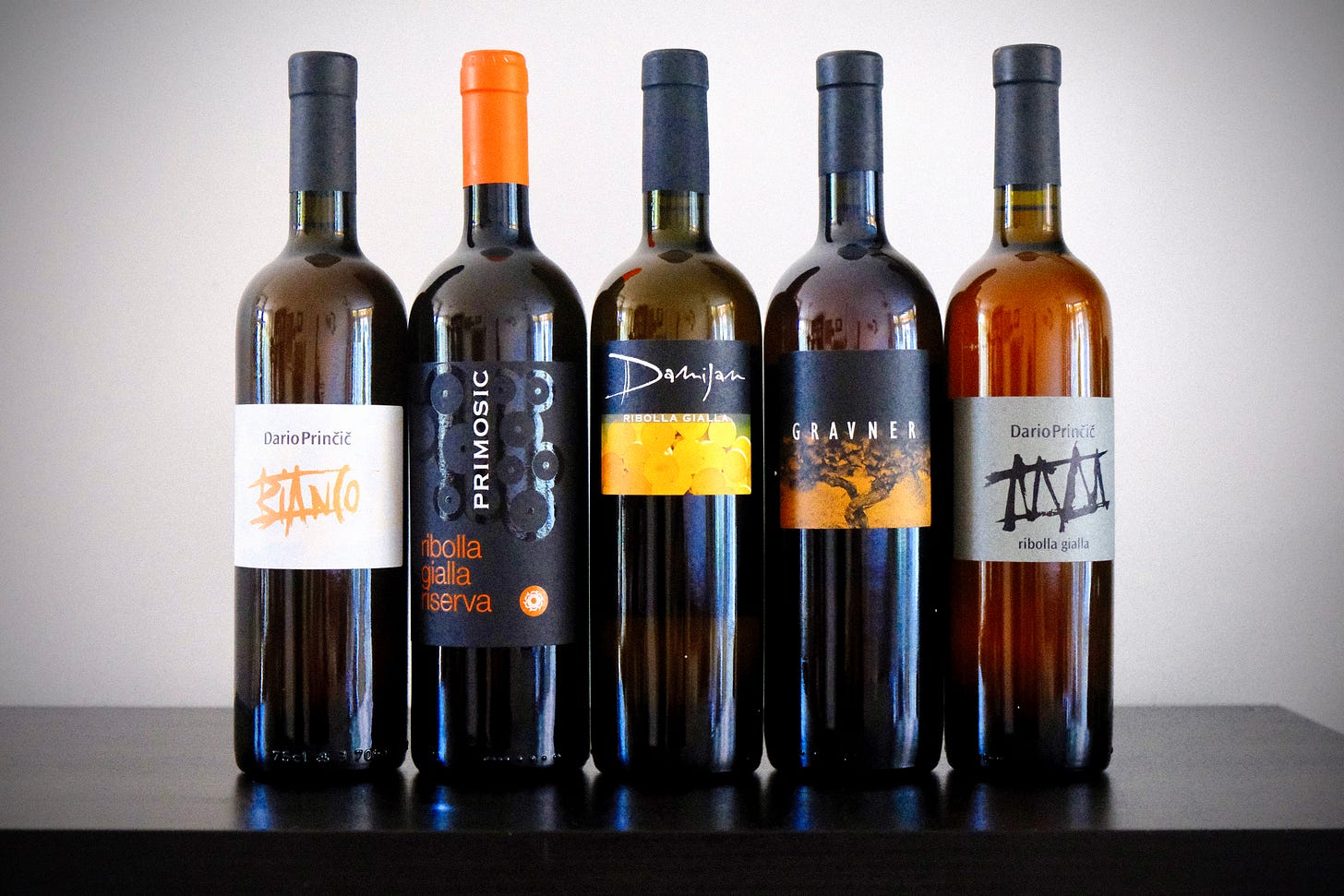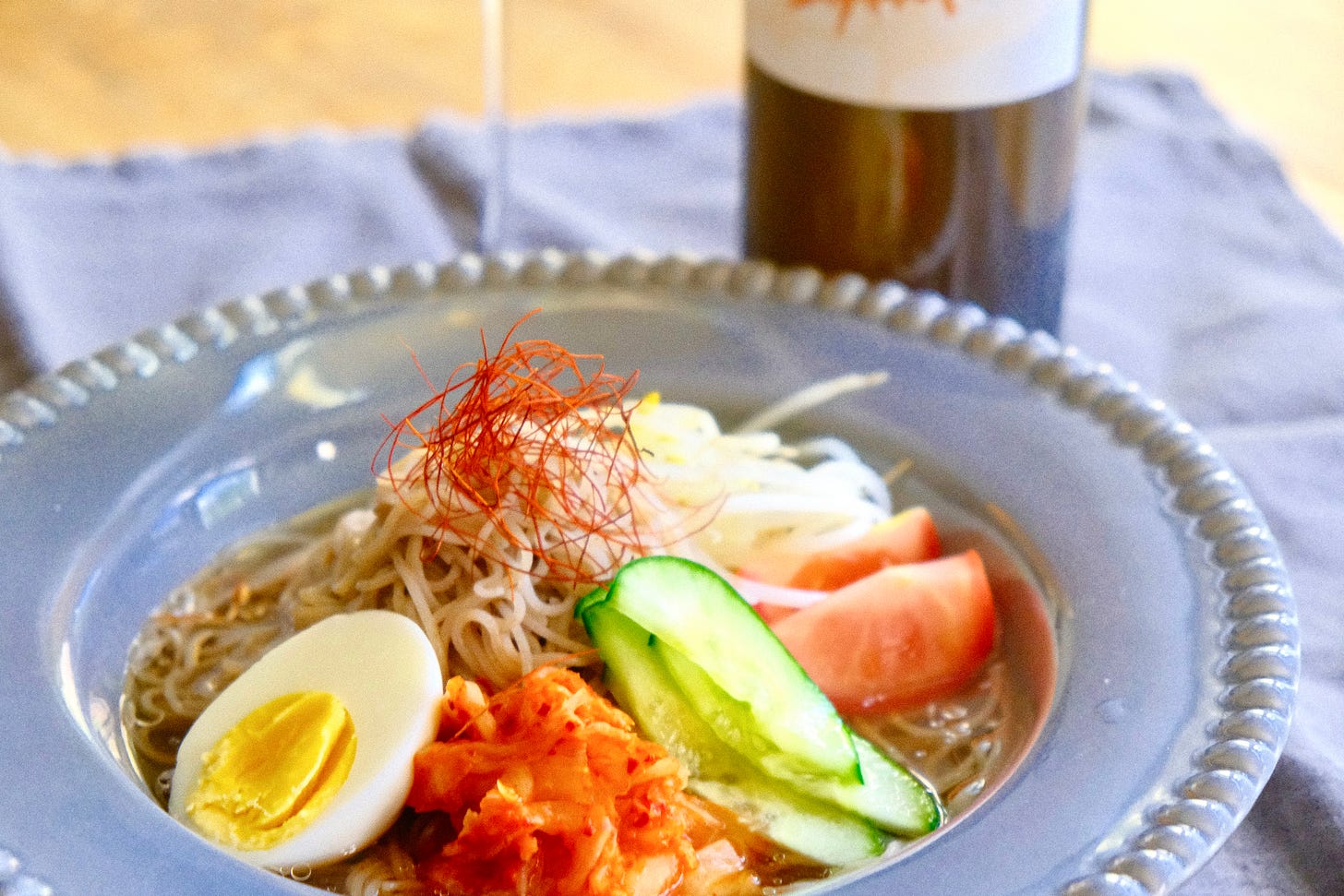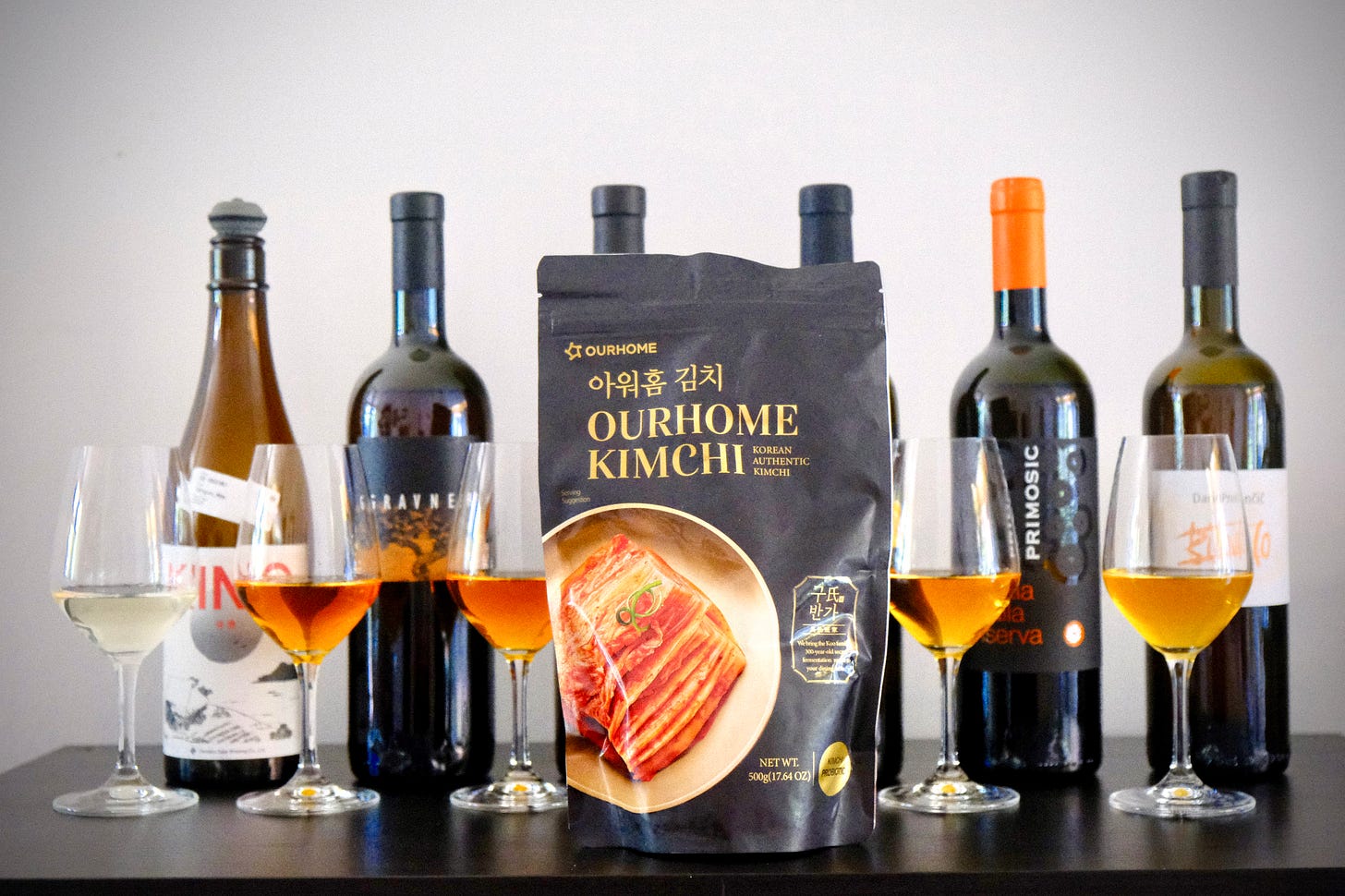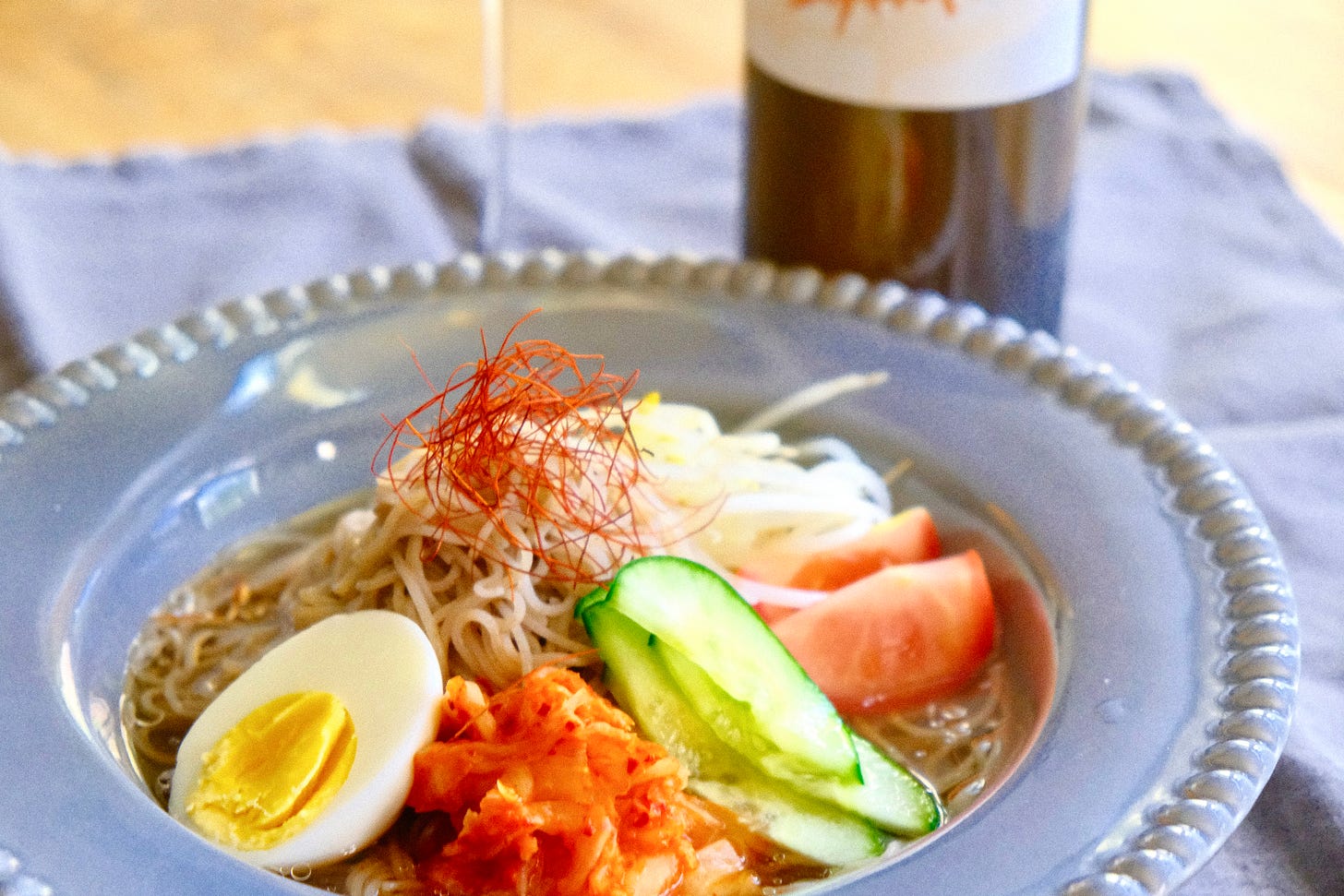The Hardest Wine Pairing I’ve Tried
What I Learned Matching Five Orange Wines with Korean Summer Dishes
From the North Adriatic to Korea
Over the past few weeks, my mind has been drifting toward the North Adriatic as I plan my next wine trip. The WSET textbook doesn’t include much about the region and barely scratches the surface of Friuli Venezia Giulia, Collio, and orange wines—leaving much to be desired. So I turned to more in-depth sources: a dense book, a few podcasts, and some informative Substacks. One gem was Simon Woolf’s The Morning Claret, which offered real insight into the region and the excellent guide—TMC Guide: Collio Orange Wines, Part 1—listed standout bottles. For my preparation, I ordered five recommended wines. Look at this lineup—pretty solid, right? Four are made from 100% Ribolla Gialla. One is a multi-vintage blend.
I wasn’t particularly familiar with orange wines before—but as I lined up these bottles, something stirred. One long-standing curiosity resurfaced: could I finally try that infamously tricky pairing I’d been mulling over for years? Kimchi.
Kimchi is a traditional Korean fermented vegetable dish, usually made with Napa cabbage and seasoned with gochugaru (chili flakes), garlic, ginger, scallions, and fish sauce or salted shrimp for umami. It’s alive—literally—fermenting with lactic acid bacteria, rich in probiotics, and ranging from mild to explosively spicy. According to my Korean friends, every family once had its own secret recipe, often stored in a dedicated fridge just for kimchi—to preserve its signature flavor and contain its pungent aroma. Japanese versions tend to be milder, sweeter, and only lightly fermented, but still feel familiar—comfort food for many of us across Asia.
And yet, pairing wine with kimchi? Notoriously difficult. The spice boosts bitterness and astringency, mutes fruit and sweetness, and can make alcohol feel even hotter. On top of that, the intense umami and funk from fermented seafood can overwhelm a wine’s balance. Honestly, it’s one of the rare moments when I reach for soju.
A Fermentation Guide (of Sorts)
Fermented foods are at once ancient and new to us—especially across Asia. In Japan, fermentation is foundational. Not just soy sauce or miso—every region has its own fermentation traditions. In Akita Prefecture, there’s Shottsuru, a fish sauce made by fermenting hatahata (sandfish) with salt over many months, often used in winter hot pots like shottsuru nabe. In Toyama, masu-zushi layers vinegared rice and cured trout in a bamboo-lined wooden box, developing gentle acidity and umami with time. And kusaya, from the Tokyo islands, is a powerfully pungent dried fish, fermented in a reused, decades-old brine. These foods have been part of our kitchens for centuries.
On the flip side, world-renowned restaurants have taken fermentation to new, innovative heights. Noma in Copenhagen is a clear leader. Their Noma Guide to Fermentation became a culinary bible—not just for chefs, but curious home cooks. Fermentation isn’t a trend anymore; it’s part of the global culinary vocabulary.
My real “Aha” moment came at Steirereck in Vienna. This Michelin-three-starred restaurant blew me away with its creative use of preserved and fermented vegetables. The techniques felt deeply Asian in origin, yet were modernized, refined, and perfectly integrated into Western cuisine at an entirely different level. What struck me most was their pairing strategy: natural wines, orange wines—even craft beers. Dishes I assumed were impossible to pair with wine, like fermented vegetables, were matched brilliantly. Some reminded me of kimchi. This was fermentation as a global conversation.
Kitchen Experiments
Now that I’ve gone on at length—here comes the fun part: testing in my own kitchen, with my favorite toy—the Coravin—in hand. The theme: kimchi and orange wines.
I made naengmyeon, a cold Korean noodle dish with chewy noodles (made from buckwheat or sweet potato starch) served in a chilled, tangy broth. I topped it with salted cucumber, bean sprouts, tomato, a boiled egg, and of course—kimchi. A classic summer dish: refreshing, slightly sour, deeply savory.
Then came the wines. All five are from Simon Woolf’s list—so check out his full guide if you're curious. For now, a few quick notes:
Dario Prinčič Bianco NV: A multi-vintage blend of Chardonnay, Sauvignon Blanc, and Pinot Grigio with brief skin contact. Bursts of blood orange, brined peach (sumomo), and a hint of preserved vegetables (think umeboshi). Bright, juicy acidity and fine tannins. Impeccably balanced sweet-sour profile with a surprisingly long finish.
Primosic Ribolla Gialla Riserva 2019: Four weeks of skin contact, full malolactic, coarsely filtered. Dried apricot, orange peel, subtle oxidative notes, and sweet spice. Full-bodied, fresh acidity, with pleasant phenolic grip on the finish.
Damijan Podversic Ribolla Gialla 2020: Macerated in large oak for 60–90 days, then aged 3 years plus a year in bottle. Bright mandarin, bruised apple, orange marmalade, saffron, spice. Sweet nose, but lean on the palate with high, juicy acidity.
Dario Prinčič Ribolla Gialla 2020: More oxidative in style. Bruised apple, orange peel, mint, tamarind, dried fruit. Mouthwatering acidity and firm tannins on the finish.
Gravner Ribolla 2016: Six months on skins in qvevri, six more post-pressing, and five years in large oak. Aged elegance: orange peel, dried apricot, candied citrus, spice. Powerful, structured, and long.
Conclusion
As I suspected from tasting on its own, the Dario Prinčič Bianco NV stole the show. Delicious on its own—and a beautiful partner for the naengmyeon with kimchi. The pairing worked because they shared similar flavor profiles: sweet-sour balance, brined fruit notes and a gentle touch of acetic acid. The broth and wine resonated in flavor, weight.
But spicy kimchi still amplified bitterness and tannins more than I expected. The longer the maceration, the trickier the pairing. Depending on your kimchi’s heat level, you may want to avoid heavily structured orange wines. Balance is key.
I loved the umami synergy between the wine and the naengmyeon with kimchi. When different types of umami compounds—like glutamate, succinic acid, and guanylate—come together, they can actually enhance each other, creating a deeper, more layered flavor experience.
I also paired with a kimoto sake—rich in lactic acid and brewed using traditional methods. But honestly, it wasn’t quite the right bottle for this kimchi. I’d love to revisit this in another post.
Want more?
Every Tuesday, I dive into core sake topics from a wine-savvy perspective—grounded, clear, and always centered on flavor. On Fridays, I explore real-world food pairings that go far beyond the usual suspects—from Thai curries to miso-laced pastas.
Thanks for reading Pairing the World: Wine, Sake, and More! If you find my work valuable, you can support me by liking, commenting, stacking, or subscribing.
ワイン史上、最も難しいペアリングだったかも
5本のオレンジワインと韓国冷麺を合わせてみた話
📍この投稿の意図
オランダ・アムステルダム在住の日本酒とワインの講師、Kazumi(DipWSET)です。
この投稿は、海外のワインのプロフェッショナル——たとえば、ワインショップのスタッフ、ソムリエ、ワインエデュケーターといった方々に、日本酒の魅力をもっと知ってもらいたいという思いから執筆しています。
日本とヨーロッパ、両方の食文化を背景に、
「日本酒やワインの魅力を自分の言葉で伝えられるようになりたい」
「日本と海外の架け橋になりたい」
そんな願いを込めて、毎週英語で発信しています。
この日本語訳は、その取り組みを日本の皆さまに知っていただくために添えています。
北アドリア海から韓国へ
ここ数週間、次のワイン旅の計画を立てながら、私の意識はずっと北アドリア海に向かっていました。WSETのテキストでは、この地域についての記述はわずかで、フリウリ・ヴェネツィア・ジュリアやコッリオ、オレンジワインについてもほとんど触れられていません。もっと深く知りたいと思い、本やPodcast、Substackの投稿など、いろいろな情報源にあたってみることに。
なかでも印象的だったのが、Simon Woolfの The Morning Claret。この中のガイド「TMC Guide: Collio Orange Wines, Part 1」で紹介されていたおすすめの5本を取り寄せて、味わってみることにしました。ご覧の通り、なかなかいいラインナップです。4本は100%リボッラ・ジャッラ、1本はマルチヴィンテージのブレンドです。
オレンジワインにはそこまで詳しくなかった私ですが、ボトルを並べた瞬間、ある好奇心がむくむくと蘇りました。
「キムチとのペアリング、そろそろやってみたい…」
キムチという難敵
キムチは言わずと知れた韓国の発酵食品。白菜を中心に、唐辛子、にんにく、生姜、ネギ、魚醤やアミエビなどで味つけされ、乳酸菌で発酵することで独特の酸味とうまみが生まれます。家庭ごとにレシピがあるといわれ、専用のキムチ冷蔵庫で保存するのが一般的だそう。日本のキムチはやや甘めでマイルドですが、それでもどこか懐かしさを感じる、アジアの「ごはんのおとも」です。
でも、このキムチにワインを合わせるのは、正直かなり難しい。辛味がワインの苦味や渋みを強調し、果実味や甘さをかき消してしまう。アルコール感も強く感じられがち。さらに魚介系の発酵調味料の“クセ”が加わると、ワインのバランスが崩れやすくなるのです。
正直、こういうときだけは私も素直にソジュに手が伸びる(笑)。
アジアの発酵、世界の発酵
発酵食品は、アジアでは昔から身近な存在です。たとえば日本なら、醤油や味噌はもちろん、地域ごとに独自の発酵文化があります。秋田のハタハタを使った魚醤「しょっつる」、富山のます寿司、そして伊豆諸島の強烈な香りで知られる「くさや」など、どれも長年の知恵と時間が生んだ味。
一方で、世界の一流レストランも発酵の可能性に着目しています。コペンハーゲンのNomaはまさにその先駆け。『Nomaの発酵ガイド』は料理人だけでなく家庭の料理好きにも愛され、発酵は一過性のトレンドではなく、“グローバルな食の共通語”になりました。
なかでも印象に残っているのは、ウィーンの三つ星レストラン Steirereck。そこでは、漬物や発酵野菜を驚くほど洗練された形で取り入れていて、どこかアジア的な技法とヨーロッパのモダン料理が美しく融合していました。なんとなくキムチを思い出させる味も!合わせるお酒も、ナチュラルワインやオレンジワイン、クラフトビールなど自由。
「キムチにワインは無理」だなんて、思い込みだったのかもしれません。
実験スタート!
ということで、今回は自宅のキッチンでペアリング実験です。テーマはもちろん「キムチ×オレンジワイン」。相棒は愛用のCoravin。
料理は、韓国の冷麺(ネンミョン)。もちもちの麺に、冷たくて酸味のあるスープ。きゅうりの塩もみ、もやし、トマト、ゆで卵、そして主役のキムチをトッピング。夏にぴったりの、さっぱり・うまみ系メニューです。
ワインはSimon Woolfのリストから選んだ5本。それぞれの印象を一言で:
Dario Prinčič Bianco NV
ブラッドオレンジや漬けたスモモ、梅干しのような塩っけ。甘酸っぱさと酸が美しく共鳴。これ合いそう。Primosic Ribolla Gialla Riserva 2019
干しあんずやオレンジピール、軽い酸化ニュアンスとスパイス感。骨格しっかりめで酸もあり。Damijan Podversic Ribolla Gialla 2020
90日間のマセラシオン。マンダリン、蜜りんご、マーマレード、サフラン。香りは甘く、口に含むとスリムで酸がはっきり。Dario Prinčič Ribolla Gialla 2020
酸化熟成寄り。煮りんご、ミント、タマリンド、干し果物。酸とタンニンが引き締める後味。Gravner Ribolla 2016
6ヶ月の甕熟成+長期熟成。オレンジピール、干しあんず、キャンディシトラス、スパイス。構造と余韻が圧倒的。
結論:うまみが鍵
予想通り、Dario Prinčič Bianco NVが最も相性がよく、美味しさも際立ちました。
冷麺とこのワインは、甘酸っぱさや塩気、軽やかな酢酸のニュアンスが共鳴していて、味の重さも揃っていました。
一方で、やはり辛味の強いキムチは、タンニンと苦味を増幅させます。マセラシオンが長いほど、ペアリングは難しくなる傾向。キムチの辛さによっては、ストラクチャーが強すぎるワインは避けたほうが良いかもしれません。
でもやっぱり、ワインと料理の「うまみの掛け算」は面白い。グルタミン酸、コハク酸、グアニル酸など、異なる種類のうまみ成分が合わさることで、味わいにより深みが出るという科学的な裏付けもあります。
ちなみに、同時に試した生酛の日本酒は…今回はキムチに負けました。また別の機会に、酒でのリベンジをしたいと思います。
読んでくださってありがとうございます!
この投稿は、ワインの視点から日本酒を学ぶ「Tuesday Sake 101」シリーズの一部です。
「Pairing the World: Wine, Sake, and More!」は、ワインと日本酒の世界をつなぐブログです。
この投稿が、日本酒とワインをつなぐ新しい視点として楽しんでいただけたなら嬉しいです。応援したいと思っていただけた方は、ぜひ「いいね」や「コメント」、ご購読(Subscribe)でサポートしていただけると励みになります。🍶🍷
なお、本シリーズにてご紹介したい日本酒や、海外向けにラインナップをご紹介希望のインポーター様・酒蔵様からのご連絡もお待ちしております。









This sounds like such an interesting experiment! I still remember the one and only time I went to Noma (about 10 years ago now) and they showed us around the various fermentation rooms... so, so cool to see (and taste, obviously!).